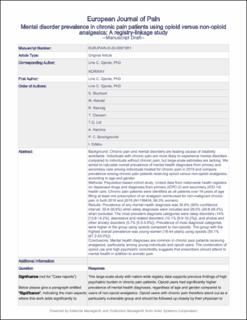| dc.contributor.author | Gjerde, L. C. | |
| dc.contributor.author | Skurtveit, S. | |
| dc.contributor.author | Handal, M. | |
| dc.contributor.author | Nesvåg, R. | |
| dc.contributor.author | Clausen, T. | |
| dc.contributor.author | Lid, T. G. | |
| dc.contributor.author | Hamina, A. | |
| dc.contributor.author | Borchgrevink, P. C. | |
| dc.contributor.author | Odsbu, I. | |
| dc.date.accessioned | 2023-06-23T13:46:26Z | |
| dc.date.available | 2023-06-23T13:46:26Z | |
| dc.date.created | 2023-05-09T10:23:09Z | |
| dc.date.issued | 2023 | |
| dc.identifier.citation | Gjerde, L.C., Skurtveit, S., Handal, M., Nesvåg, R., Clausen, T., Lid, T.G., Hamina, A., Borchgrevink, P.C.& Odsbu, I. (2023) European Journal of Pain. | en_US |
| dc.identifier.issn | 1090-3801 | |
| dc.identifier.uri | https://hdl.handle.net/11250/3072933 | |
| dc.description.abstract | Background Chronic pain and mental disorders are leading causes of disability worldwide. Individuals with chronic pain are more likely to experience mental disorders compared to individuals without chronic pain, but large-scale estimates are lacking. We aimed to calculate overall prevalence of mental health diagnoses from primary and secondary care among individuals treated for chronic pain in 2019 and to compare prevalence among chronic pain patients receiving opioid versus non-opioid analgesics, according to age and gender. Methods It is a population-based cohort study. Linked data from nationwide health registers on dispensed drugs and diagnoses from primary (ICPC-2) and secondary (ICD-10) health care. Chronic pain patients were identified as all patients over 18 years of age filling at least one prescription of an analgesic reimbursed for non-malignant chronic pain in both 2018 and 2019 (N = 139,434, 69.3% women). Results Prevalence of any mental health diagnosis was 35.6% (95% confidence interval: 35.4%–35.9%) when sleep diagnoses were included and 29.0% (28.8%–29.3%) when excluded. The most prevalent diagnostic categories were sleep disorders (14% [13.8%–14.2%]), depressive and related disorders (10.1% [9.9%–10.2%]) and phobia and other anxiety disorders (5.7% [5.5%–5.8%]). Prevalence of most diagnostic categories was higher in the group using opioids compared to non-opioids. The group with the highest overall prevalence was young women (18–44 years) using opioids (50.1% [47.2%–53.0%]). Conclusions Mental health diagnoses are common in chronic pain patients receiving analgesics, particularly among young individuals and opioid users. The combination of opioid use and high psychiatric comorbidity suggests that prescribers should attend to mental health in addition to somatic pain. Significance This large-scale study with nation-wide registry data supports previous findings of high psychiatric burden in chronic pain patients. Opioid users had significantly higher prevalence of mental health diagnoses, regardless of age and gender compared to users of non-opioid analgesics. Opioid users with chronic pain therefore stand out as a particularly vulnerable group and should be followed up closely by their physician to ensure they receive sufficient care for both their mental and somatic symptoms. | en_US |
| dc.language.iso | eng | en_US |
| dc.subject | smertestillende | en_US |
| dc.subject | opioider | en_US |
| dc.subject | kronisk smerte | en_US |
| dc.subject | psykisk helse | en_US |
| dc.subject | mental helse | en_US |
| dc.title | Mental disorder prevalence in chronic pain patients using opioid versus non-opioid analgesics: A registry-linkage study | en_US |
| dc.type | Peer reviewed | en_US |
| dc.type | Journal article | en_US |
| dc.description.version | acceptedVersion | en_US |
| dc.rights.holder | © 2023 European Pain Federation - EFIC ®. | en_US |
| dc.subject.nsi | VDP::Medisinske Fag: 700::Klinisk medisinske fag: 750 | en_US |
| dc.source.pagenumber | 1-12 | en_US |
| dc.source.journal | European Journal of Pain | en_US |
| dc.identifier.doi | 10.1002/ejp.2121 | |
| dc.identifier.cristin | 2146352 | |
| dc.relation.project | Norges forskningsråd: 320360 | en_US |
| cristin.ispublished | true | |
| cristin.fulltext | postprint | |
| cristin.qualitycode | 1 | |
